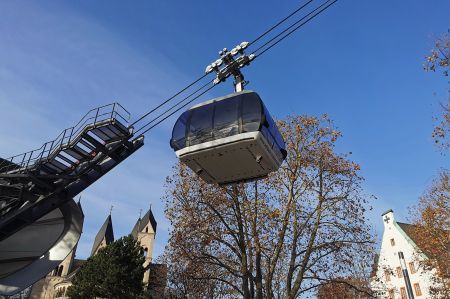Koblenz cable car with a view of the Ehrenbreitstein Fortress
- Written by Portal Editor
When planning the Federal Garden Show 2011, Koblenz faced a problem that also had to be overcome in Cologne in 1957 for the Federal Garden Show there, because how could the core areas of the show on the left bank of the Rhine, which are far apart, be connected with those on the Ehrenbreitstein.
A bus connection or, as in Cologne, a cable car over the Rhine was up for debate. The decisive factor for the construction of a cable car was its positive ecological balance compared to the bus transfer of thousands of visitors. Various routes were also discussed, but in the end the decision was made to take the direct route variant up to the fortress plateau.
A cable car as a solution to the problem
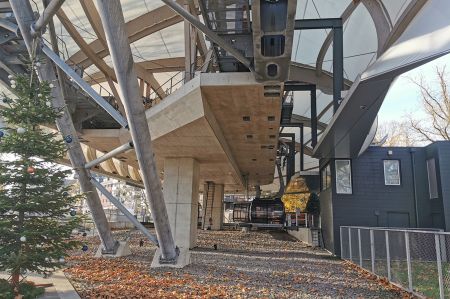 In November 2008, the decision was made to have the gondola lift built by an experienced Austrian company. The concession agreement stipulated that the company would build and operate the cable car and dismantle it again in November 2013.
In November 2008, the decision was made to have the gondola lift built by an experienced Austrian company. The concession agreement stipulated that the company would build and operate the cable car and dismantle it again in November 2013.
The dismantling after three years was originally considered necessary in order not to jeopardize the UNESCO World Heritage status of the “Upper Middle Rhine Valley Cultural Landscape”. At the same time, the citizens' initiative "Pro Seilbahn" endeavoured to preserve the cable car - also because of its ecological balance - beyond the planned dismantling date. So points of contention were inevitable.
Start of construction and completion of the cable car
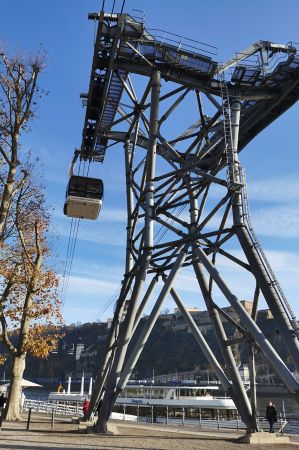 Construction began on April 15, 2009 with the felling of the first trees. Environmentalists criticized the necessary tree felling in the Rhine facilities of Koblenz, so the trees were replaced in a ratio of one to three as compensation.
Construction began on April 15, 2009 with the felling of the first trees. Environmentalists criticized the necessary tree felling in the Rhine facilities of Koblenz, so the trees were replaced in a ratio of one to three as compensation.
The two stations, including the cable car supports, were completed by December 2009. The cable car was completed in June 2010 and officially inaugurated on July 2, 2010.
From July 4, 2010, public transport operations began for about three months. Already in the first month of operation, 50,000 passengers used the cable car, by the end of the first public service at the beginning of October 2010 there were almost 180,000 passengers.
Regular operation started with the opening of the Federal Horticultural Show on April 15, 2011. The construction costs for the gondola cableway were around twelve million euros.
UNESCO approves continued operation
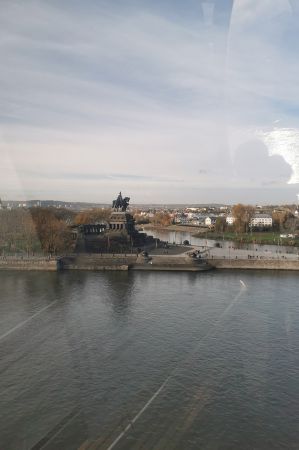 In April 2011 it became known that the city of Koblenz was negotiating with Doppelmayr to operate the Koblenz cable car for five years. Permanent operation is also conceivable but depends on negotiations with UNESCO.
In April 2011 it became known that the city of Koblenz was negotiating with Doppelmayr to operate the Koblenz cable car for five years. Permanent operation is also conceivable but depends on negotiations with UNESCO.
On the 7th UNESCO World Heritage Day in June 2011, UNESCO announced that the Koblenz cable car was and could remain a World Heritage site.
After negotiations with the city of Koblenz at the end of 2012, the operator Doppelmayr is interested in continuing to operate the cable car.
Criticism of continued operation came in November 2012 from the Diocese of Trier, fearing that the Basilica of St. Castor would be adversely affected.
With the cable car, the Ehrenbreitstein Fortress could be optimally developed for the first time, which is also recognized by UNESCO.
 On June 19, 2013 in Phnom Penh, UNESCO decided at the 37th session of the World Heritage Committee to allow the cable car to operate until 2026. The technically longest possible operating time ends this year. This decision, which came as a surprise to everyone, came after representatives of the federal government advocated preservation at the meeting of the World Heritage Committee, which was supported by countries such as France, Colombia, Mali, Senegal, Serbia and Switzerland.
On June 19, 2013 in Phnom Penh, UNESCO decided at the 37th session of the World Heritage Committee to allow the cable car to operate until 2026. The technically longest possible operating time ends this year. This decision, which came as a surprise to everyone, came after representatives of the federal government advocated preservation at the meeting of the World Heritage Committee, which was supported by countries such as France, Colombia, Mali, Senegal, Serbia and Switzerland.
For the city of Koblenz and the operator of the cable car, the UNESCO decision means planning security and for Ehrenbreitstein Fortress an expansion of cultural activities. Since operation was only planned for four years, the operator had to adapt the infrastructure around the cable car to the continuous operation that was now possible. For this purpose, the provisional ticket booths were replaced by permanent buildings that can be used all year round. A depot for twelve cabins and an inspection car park including storage was planned at the mountain station, but this has not yet been built. In 2013, the Koblenz cable car carried around 650,000 people. On June 5, 2015, the ten millionth ride on the Koblenz cable car was completed.
Technical data for the Koblenz cable car
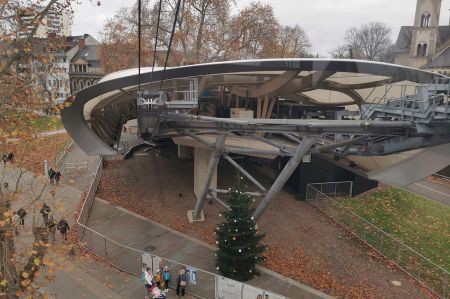 With a maximum capacity of 7600 people per hour in both directions, it is the world's leading aerial cableway. The driving speed can be increased up to 5.5 m/s.
With a maximum capacity of 7600 people per hour in both directions, it is the world's leading aerial cableway. The driving speed can be increased up to 5.5 m/s.
The glazed panorama cabins offer a wide view of the Middle Rhine Valley and commute between the two stations in four to five minutes.
The cable car is powered by an electric motor with an output of 956 kilowatts/1300 hp that runs on green electricity.
The energy requirement per passenger kilometre and the associated CO2 emissions depend on capacity utilization. According to a publication by Doppelmayr / Austria, 1046 MWh of energy was required for the cable car during the Federal Horticultural Show.
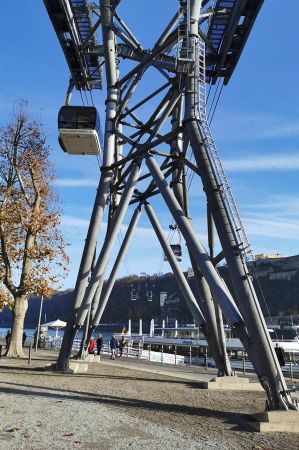 Cabin number 17 was equipped with a glass table with a view downwards, cabin number 18 is intended as an example for future cable cars in local public transport and was equipped with a special seating arrangement and interior design as well as an information system. The cabins each weigh 3.5 tons including the running gear.
Cabin number 17 was equipped with a glass table with a view downwards, cabin number 18 is intended as an example for future cable cars in local public transport and was equipped with a special seating arrangement and interior design as well as an information system. The cabins each weigh 3.5 tons including the running gear.
Storms do not pose an increased risk for this type of ropeway. Since the cabins are on two supporting ropes, they have a high level of wind stability. However, from a wind speed of 80 km/h (storm) the operation is stopped for safety reasons. As the rapid storm on August 26, 2011 showed, during which operations could not be stopped in time, peak wind speeds of 147 km/h (hurricane force) had no impact on operations. In the event of an operational disruption, four emergency drive motors ensure that all cabins can still drive into a station (evacuation concept).
Please also read:
Balaton - Lake Balcsi - not just an intermediate destination
